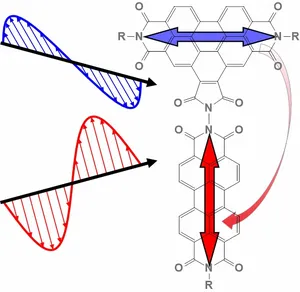
Transient Anisotropy
The optical spectra of molecules are often highly congested, making definite assignment of features and dynamics difficult. We use a polarization-based strategy for the decomposition of transient absorption (TA) signals. In this approach, the polarization-associated spectra (PAS) can be isolated to the contributions either parallel or orthogonal to the initially excited transition dipole moment (TDM) of the molecule. An analysis based on PAS
- Makes the interpretation of TA signals much easier or even possible.
- Retrieves the relative angle between different TDMs in the molecule, which is important structural information.
Involved group members

Yi Xu
yi.xu@tum.de

Maximilian Binzer
maximilianbinzer@binzer.de

Erling Thyrhaug
erling.thyrhaug@tum.de
Further reading
Albrecht, A. C. Polarizations and assignments of transitions: The method of photoselection. Journal of Molecular Spectroscopy 1961, 6, 84-108. DOI: 10.1016/0022-2852(61)90234-X.
Own work
Xu, Y.; Mewes, L.; Thyrhaug, E.; Sláma, V.; Šanda, F.; Langhals, H.; Hauer, J. Isolating Pure Donor and Acceptor Signals by Polarization-Controlled Transient Absorption Spectroscopy. The Journal of Physical Chemistry Letters 2023, 14 (23), 5390-5396. DOI: 10.1021/acs.jpclett.3c01451.
